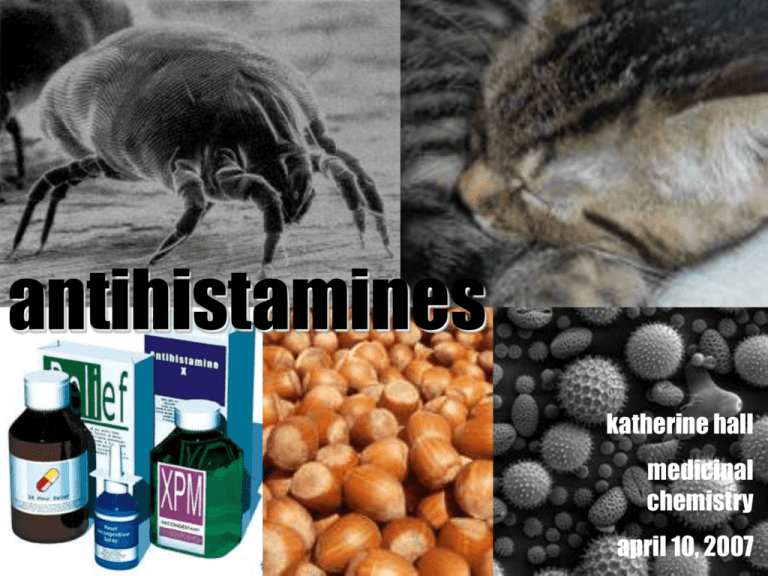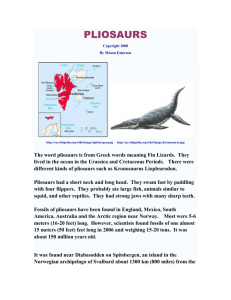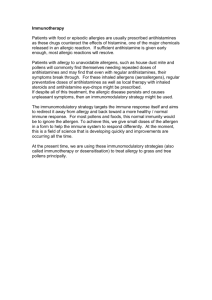antihistamines
advertisement

antihistamines katherine hall medicinal chemistry april 10, 2007 Outline • What is an antihistamine? • What causes allergies and what are they, what is histamine? • History of antihistamines • Classes of antihistamines • Future of antihistamines and allergy treatment in general What is an antihistamine? • A drug that reduces or eliminates the effects mediated by the chemical histamine • Histamine is released by your body during an allergic reaction and acts on a specific histamine receptor • True antihistamines are only the agents that produce a therapeutic effect that is mediated by negative modulation of histamine receptors (other agents may have antihistaminergic action but are not true antihistamines) • The term antihistamine only refers to H1 receptor antagonists (actually inverse agonists) • Antihistamines compete with histamine for binding sites at the receptors. Antihistamine cannot remove the histamine if it is already bound What are allergies? • Allergies are caused by a hypersensitivity reaction of the antibody class IgE (which are located on mast cells in the tissues and basophils in the blood) • When an allergen is encountered, it binds to IgE, which excessively activates the mast cells or basophils, leading them to release massive amounts of histamines. • These histamines lead to inflammatory responses ranging from runny nose to anaphylactic shock • If both parents have allergies, you have a 70% of having them, if only one parent does, you have a 48% chance (American Academy of Asthma, Allergies and Immunology, Spring 2003). Allergies Structure of Histamine Mast Cells •Histamine is distributed in Mast Cells in all peripheral tissues of the body and basophils, which circulate in the blood •When it is released, histamine causes inflammation by increasing vasodilation, capillary permeability, causing smooth muscle contraction, mucus secretion, and parasympathetic nerve stimulation Synthesis of Histamine • Formed from the amino acid Histadine in a decarboxylation reaction with the enzyme histadine decarboxylase • Occurs primarily in mast cells and basophils http://www.fao.org/docrep/006/y4743e/y4743e0k.gif The different Histamine receptors Location Type of receptor Effect Treatment H1 Throughout the body, specifically in smooth muscles, on vascular endothelial cells, in the heart and the CNS G-protein coupled, linked to intercellular Gq, which activates phospholipase C Mediate an increase in vascular permeability at sites of inflammation induced by histamine Allergies, nausea, sleep disorders H2 In more specific locations in the body mainly in gastric parietal cells, a low level can be found in vascular smooth muscle, neutrophils, CNS, heart, uterus G-protein coupled, linked to intercellular Gs Increases the release of gastric acid Stomach ulcers H3 Found mostly in the CNS, with a high level in the thalamus, caudate nucleus and cortex, also a low level detected in small intestine, testis and prostate. G-protein coupled, possibly linked to intercellular Gi Neural presynaptic receptor, may function to release histamine Unknown H4 They were recently discovered in 2000. They are widely expressed in components of the immune system such as the spleen, thymus and leukocytes. Unknown, most likely also Gprotein coupled Unknown In addition to benefiting allergic conditions, research in the h4 receptor may lead to the treatment of autoimmune diseases. (rheumatoid arthritis and IBS) Why is this important? • Allergies are very common in America, 50 million people suffer from them (about 1 in 4 people) • Allergies are the 6th leading cause of chronic disease and they cause the health care system $18 billion annually • Over 60% of people with allergies develop asthma as well • Keeping them under control is very important!! Clinical Uses of Antihistamines • • • • • • • • Allergic rhinitis (common cold) Allergic conjunctivitis (pink eye) Allergic dermatological conditions Urticaria (hives) Angioedema (swelling of the skin) Puritus (atopic dermatitis, insect bites) Anaphylactic reactions (severe allergies) Nausea and vomiting (first generation H1antihistamines) • Sedation (first generation H1-antihistamines) http://www2.nphs.wales.nhs.uk/icds/documents/conjunctivitis2.jpg Adverse side effects • Associated with the first generation H1-antihistamines and due to their lack of selectivity for the H1 receptor and anti-cholinergic activity. Side effects are due to CNS depression: • • • • • • • • • • • Sedation Dizziness Tinnitus (ringing in the ear) Blurred vision Euphoria Uncoordination Anxiety Insomnia Tremor Nausea/vomitting Dry mouth/dry cough • Newer second generation H1-antihistamines are more selective for the peripheral histamine receptors and have far less side effects (drowsiness, fatigue, headache, nausea and dry mouth) First antihistamine • Piperoxan • Discovered in 1933 by Jeff Forneau and Daniel Bovent while developing a guinea pig animal model of anaphylaxis • They received the Nobel Prize in 1957 http://www.registech.com/images/ce.jpg Classes of first generation H1 receptor antagonist antihistamines • • • • • Ethylenediamines Ethanolamines Alkylamines Piperazines Tricyclics Common Structural Features of classical first generation antihistamines • 2 aromatic rings, connected to a central carbon, nitrogen, or oxygen • Spacer between central atom and the amine, usually 2-3 carbons in length. (Can be linear, ring, branched, saturated or unsaturated) • The amine is substituted with small alkyl groups • Chirality at X and having the rings in different planes increases potency of the drug Ethylenediamines • These were the first group of clinically effective H1-antihistamines Mepyramine (Pyrilamine) http://en.wikipedia.org/wiki/Mepyramine Ethanolamines • This class has significant anticholinergic side effects and sedation, however reduced the gastroinestnal side effects Diphenhydramine (Benedryl) • Oldest and most effective antihistamine on the market • Available over the counter • Because it induces sedation, it’s used in nonprescription sleep aids such as Tylenol PM • Also inhibits the reuptake of serotonin, which led to the search for viable antidepressants with similar structures (prozac) http://en.wikipedia.org/wiki/Image:Diphenhydramine_Structure.png Ethanolamines Carbinoxamine(Clistine) Doxylamine succinate •Is used to treat Hay fever and is especially popular to children due its its mild taste •2nd in effectiveness of anti-allergy activity only to Benadryl •After 21 reported deaths in children under 2, its now only marketed to children above 3 (FDA, June 2006) •Active ingredient in NyQuil •Potent anti-cholinergic effects http://en.wikipedia.org/wiki/Image:Doxylamine.png Ethanolamines Clemastine (Tavist) •Exhibits fewer side effects than most antihistamines •Widely used as an antiprurtic (stops itching) Dimenhydrinate (Dramamine) •Anti-emetic (anti nausea) •Also causes strong sedation •Readily crosses the BBB http://redpoll.pharmacy.ualberta.ca/drugbank/ cgi-bin/getCard.cgi?CARD=APRD00875.txt http://redpoll.pharmacy.ualberta.ca/drugbank/cgi-bin/getCard.cgi?CARD=APRD00924.txt Alkylamines • Isomerism is an important factor in this class of drugs, which is due to the positioning and fit of the molecules in the H1-receptor binding site • These drugs have fewer sedative and GI adverse effects, but a greater incidence of CNS stimulation • These drugs lack the “spacer molecule” (which is usually a nitrogen or oxygen) between the two aromatic rings and at least one of the rings has nitrogen included in the aromatic system Akylamines Brompheniramine (Dimetapp) Chlorphenamine •Originally used to prevent allergic conditions •Shown to have antidepressant properties and inhibit the reuptake of serotonin •The first SSRI was made as a derivative of chlorphenamine •Available over the counter •Used to treat the common cold by relieving runny nose, itchy, watery eyes and sneezing http://redpoll.pharmacy.ualberta.ca/drugbank/drugBank/PC_IMAGE/APRD00832_ZOOM.gif Akylamines Triprolidine hydrochloride Pheniramine (Avil) •Used to alleviate the symptoms associated with allergies •Used most often to treat hay fever or urticaria (hives) •Can be combined with other cold medicine to relieve “flu-like” symptoms •Antihistamine component of Visine-A http://en.wikipedia.org/wiki/Image:Triprolidine.svg http://www.chiralpure.com/Figures/pheniramine.jpg Piperazines • Structurally related to the ethylenediamines and the ethanolamines and thus produce significant anti-cholinergic effects • Used most often to treat motion sickness, vertigo, nausea and vomiting Cyclizine •Used to treat the symptoms associated with motion sickness, vertigo and post-op following administration of general anaesthesia and opiods http://en.wikipedia.org/wiki/Image:Cyclizine.svg •Mechanism of inhibiting motion sickness is not well understood, but it may act on the labyrinthine apparatus and the chemoreceptor trigger zone (area of the brain which receives input and induces vomiting) Piperazines Chlorcyclizine •This drug is used to treat motion sickness http://en.wikipedia.org/wiki/Image:Chlorcyclizine.png Hydroxyzine •In addition to treating itches and irritations, its an anitemetic, a weak analgesic and an anxiolytic (treat anxiety) http://en.wikipedia.org/wiki/Image:Hydroxyzine.png Piperazines Meclizine •It is most commonly used to inhibit nausea and vomiting as well as vertigo, however it does cause drowsiness Cetirizine (Zyrtec) •This drug treats indoor and outdoor allergies and is safe to use in children as young as 2 http://redpoll.pharmacy.ualberta.ca/drugbank/drugBank/PC_IMAGE/APRD00354_ZOOM.gif Tricyclics • These drugs are structurally related to tricyclic antidepressants, which explains why they have cholinergic side effects Promethazine (Phenegran) •This drug has extremely strong anticholinergic and sedative effects •It was originally used as an antipsychotic, however now it is most commonly used as a sedative or antinausea drug (also severe morning sickness) and requires a prescription http://upload.wikimedia.org/wikipedia/commons/c/c9/Promethazine.png Tricyclics Cyproheptadine •This drug both an antihistamine and an antiserotonergic agent •It is a 5-HT2 receptor antagonist and also blocks calcium channels •Used to treat hay fever and also to stimulate appetite in people with anorexia •It is also rarely used to treat SSRI induced sexual dysfunction and also Cushing’s Syndrome (high level of cortisol in the blood) and migraine headaches http://en.wikipedia.org/wiki/Image:Cyproheptadine.png Ketotifen (Zaditor) •This drug is available in two forms: an ophthalmic form used to treat allergic conjunctivitis or itchy red eyes and an oral form used to prevent asthma attacks •It has several adverse side effects including drowsiness, weight gain, dry mouth, irritability and increased nosebleeds http://en.wikipedia.org/wiki/Image:Ketotifen.png Tricyclics Alimemazine (Vallergan) •This drug is used to treat itchiness and hives that results from allergies •Since it causes drowsiness, it is useful for rashes that itch worse at night time •It is also used to sedate young children before operations http://www.genome.jp/Fig/compound/C07172.gif Azatadine (Optimine or Trinalin) •This drug is used to treat symptoms of allergies and the common cold such as sneezing, runny nose, itchy watery eyes, itching, hives and rashes http://www.genome.jp/Fig/compound/C07774.gif Second generation H1-receptor antagonists • These are the newer drugs and they are much more selective for the peripheral H1-receptors involved in allergies as opposed to the H1-receptors in the CNS • Therefore, these drugs provide the same relief with many fewer adverse side effects • The structure of these drugs varies and there are no common structural features associated with them • They are however bulkier and less lipophilic than the first generation drugs, therefore they do not cross the BBB as readily • Recent studies have also showed that these drugs also have anti-inflammatory activity and therefore, would be helpful in the management of inflammation in allergic airways disease (Devalia and Davies). Second generation H1-receptor antagonists Acrivastine (Semprex-D) Astemizole (Hismantol) •This drug has a long duration of action •It suppresses the formation of edema and puritus •It doesn’t cross the BBB •This drug relieves itchy rashes and hives •It has been taken off the market in most countries because of adverse interactions with erythromycin and grapefruit juice •It is non-sedating because it does not cross the BBB http://en.wikipedia.org/wiki/Image:Acrivastine.svg http://en.wikipedia.org/wiki/Image:Astemizole.png Second generation H1-receptor antagonists Loratadine (Claritin) Terfenadine (Seldane) •It is the only drug of its class available over the counter •It was formerly used to treat allergic conditions •It has long lasting effects and does not cause drowsiness because it does not cross the BBB •In the 1990’s it was removed from the market due to the increased risk of cardiac arrythmias http://en.wikipedia.org/wiki/Image:Loratadin.svg http://scienceblogs.com/moleculeoftheday/images/terfenadine.gif Second generation H1-receptor antagonists Azelastine (Astelin or Optivar) Levocabastine (Livostin) Olopatadine (Patanol) •It is a mast cell stablilizer •Available as a nasal spray (Astelin) or eye drops for pink eye (Optivar) http://en.wikipedia.org/wiki/Image:Azelastine.png •Both of these drugs are used as eye drops to treat allergic conjunctivitis http://en.wikipedia.org/wiki/Image:Levocabastine.png Third generation H1-receptor antagonists • These drugs are derived from second generation antihistamines • They are either the active enantiomer or metabolite of the second generation drug designed to have increased efficacy and fewer side effects Levocetirizine (Zyzal) •This drug is the active enantiomer of cetirizine and is believed to be more effective and have fewer adverse side effects. •Also it is not metabolized and is likely to be safer than other drugs due to a lack of possible drug interactions (Tillement). •It does not cross the BBB and does not cause significant drowsiness •It has been shown to reduce asthma attacks by 70% in children http://en.wikipedia.org/wiki/Image:Levocetirizine.png Third generation H1-receptor antagonists Deslortadine (Clarinex) •It is the active metabolite of Lortadine •Even though it is thought to be more effective, there is no concrete evidence to prove this http://en.wikipedia.org/wiki/Image:Desloratadine.png Fexofenadine (Allegra) •It was developed as an alternative to Terfenadine •Fexofenadine was proven to be more effective and safe http://en.wikipedia.org/wiki/Image:Fexofenadine_Structure.png The future of antihistamines • The anti-inflammatory activity of second generation antihistamines, about which little is known, will continue to be researched and possibly lead to an effective alternative to corticosteriods in the treatment of allergic airways conditions. • The action of the H4 receptor will also continue to be researched and will possibly lead to effective treatment of autoimmune dieseases. • Creating antihistamines with higher selectivity and less adverse side effects will continue to be the goal References Cuss, F.M. “Beyond the histamine receptor: effect of antihistamine on mast cells.” Clinical and Experimental Allergy Review 1999; 29: 54-59. Devalia, J.L. and R.J. Davies. “Effect of antihistamines on epithelial cells.” Clinical and Experimental Allergy Review 1999; 29: 64-68. Mosges, R. and N. Krug. “Efficacy of antihistamines: from the precision of challenge models to the alchemy of clinical practice.” Clinical and Experimental Allergy Review 2006; 6: 20-24. Tillement, J.P. “Pharmacological profile of the new antihistamines.” Clinical and Experimental Allergy Review 2005; 5:7-11 http://www.netdoctor.co.uk/medicines/100002712.html http://www.drugs.com http://en.wikipedia.org/wiki/Antihistamines http://www.drugbank.com






